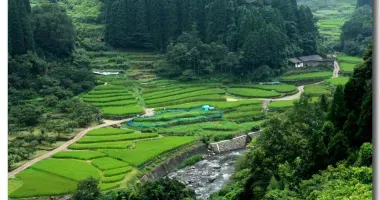Misumi Kumamoto: Gateway to Amakusa and UNESCO World Heritage Site
- Published on : 23/07/2024
- by : Japan Experience
- Youtube
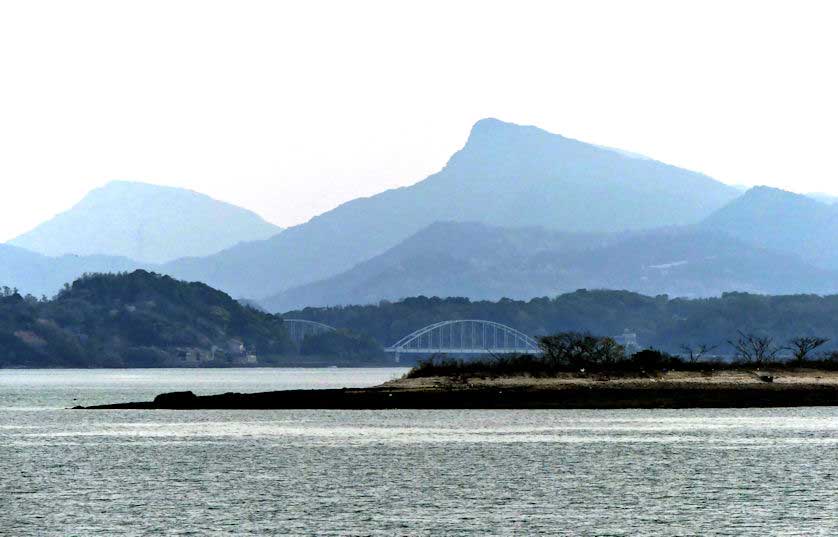
The view of the Amakusa Islands from Misumi Port
Nestled on the southwestern tip of Kumamoto Prefecture, Misumi is a small yet significant port town with a rich history and stunning natural beauty. This charming locale serves as the gateway to the Amakusa Islands, a picturesque archipelago renowned for its hidden Christian heritage and dolphin-watching opportunities. Since 2015, Misumi West Port has earned UNESCO World Heritage status, further elevating its importance as a cultural and historical landmark. With its unique blend of maritime charm, industrial heritage, and scenic vistas, Misumi offers visitors a captivating glimpse into Japan's past and present.
Introduction to Misumi: Location and historical significance
Misumi is strategically located at the tip of a peninsula southwest of Kumamoto city. Its geographical position has played a crucial role in shaping its history and importance. The town's proximity to the Amakusa Islands has earned it the moniker "Gateway to Amakusa". These islands, now connected to the mainland via the famous Five Bridges of Amakusa, were once home to a significant population of Hidden Christians, adding a layer of cultural intrigue to the area.
Misumi's historical significance took on a new dimension in 2015 when Misumi West Port was designated as a UNESCO World Heritage Site. This recognition places it among the 23 Sites of Japan's Meiji Industrial Revolution, focusing on Iron and Steel, Shipbuilding and Coal Mining. The port's inclusion in this prestigious list has significantly boosted tourism, drawing history enthusiasts and cultural explorers from around the world.
The town's development is closely tied to Japan's rapid industrialization during the Meiji era. Misumi West Port, constructed in 1887, was one of three ports specifically built for exporting goods. Its creation was deemed more economical than upgrading the existing Misumi Port to accommodate larger vessels. The port's design, influenced by Dutch engineer A. Rouwenhorst Mulder, showcases a fascinating blend of Western engineering principles and traditional Japanese craftsmanship.
Transportation options to and from Misumi
The JR Misumi Line serves as the primary rail connection to Misumi. This line terminates at Misumi Station, with its starting point 25 kilometers away in Uto, connecting to the Kagoshima Main Line and ultimately to Kumamoto Station. Travelers from Kumamoto can reach Misumi in just 52 minutes on the local service, costing 740 yen.
For a more luxurious journey, visitors can opt for the special Limited Express service featuring the "A" Train. This elegant, reservation-only sightseeing train, named after a famous jazz tune, offers a unique travel experience. Designed by Eiji Mitooka, known for his work on other special trains in Kyushu like the Kawasemi Yamasemi, Sonic, and Yufuin no Mori, the A Train boasts a retro interior and even features a bar serving alcohol. Operating primarily on weekends and holidays, it makes two round trips daily, timed to connect with ferry services to Amakusa.
For those preferring road travel, bus services provide an alternative means of reaching Misumi and the Amakusa Islands. The Kyushu Sanko Bus operates an express service from Kumamoto to Hondo, stopping near Misumi Station. This journey takes about 80 minutes and costs around 1,600 yen. Additionally, smaller local buses connect Misumi to various parts of Amakusa, offering a slower but more scenic route through smaller villages.
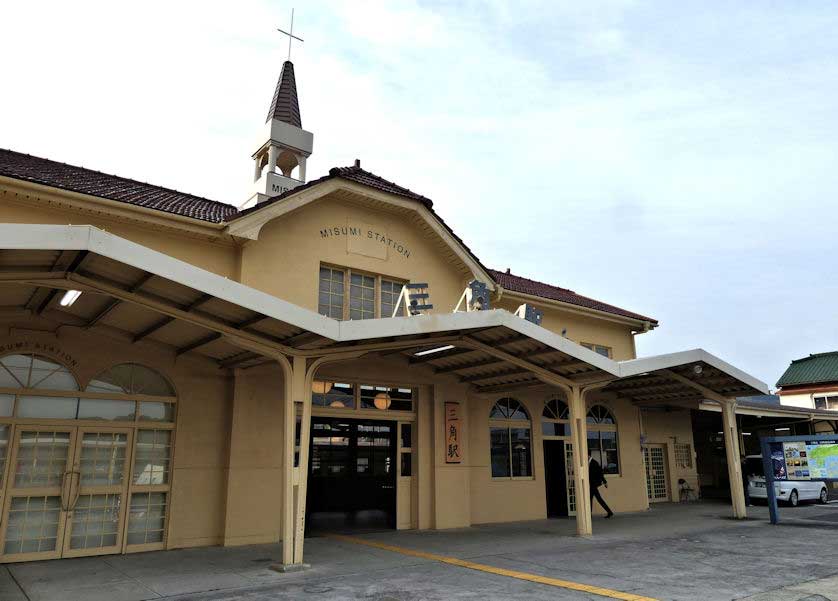
JR Misumi Station
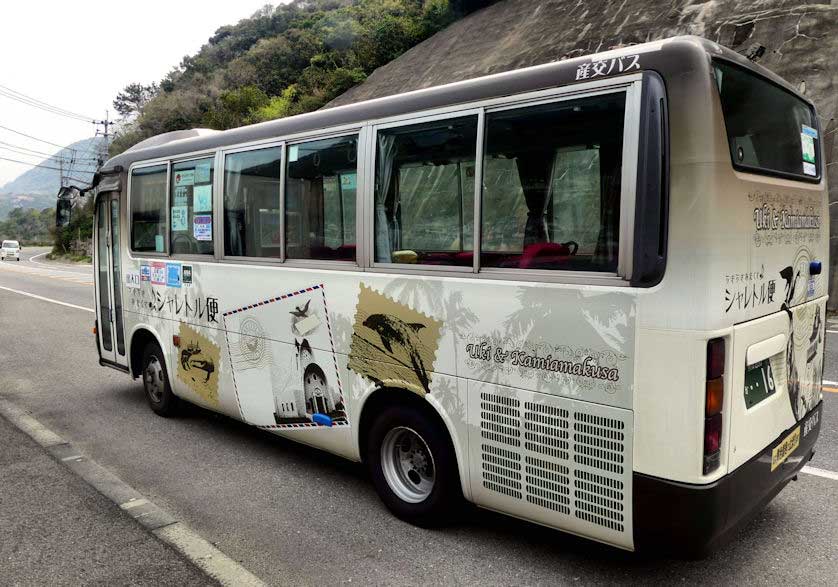
Small local buses run across to and between the Amakusa Islands
Misumi West Port: A UNESCO World Heritage Site
Misumi West Port stands as a testament to Japan's rapid industrialization during the Meiji period. Constructed between 1884 and 1887, the port was designed with a 730-meter long stone wharf and a floating pier, complemented by well-planned roads and drainage canals. This infrastructure showcases a unique fusion of Western engineering principles and traditional Japanese stone masonry techniques.
The port's primary function was to facilitate the export of coal from the Miike Mines, located 40 kilometers to the north. It also served as an export hub for other commodities such as rice and wheat. The development of the port led to the growth of a small town around the harbor, featuring a mix of Western and Japanese architectural styles.
Interestingly, the famous Greek-born author Lafcadio Hearn spent time in Misumi and reportedly enjoyed his stay. This historical connection adds another layer of cultural significance to the site.
Today, visitors can explore several well-preserved historic buildings that offer a glimpse into the port's heyday. These include the old courthouse, town hall, county office, and a shipping company office and warehouse. Many of these structures are open to the public free of charge, with some converted into cafes, providing a unique atmosphere for visitors to immerse themselves in the port's history.
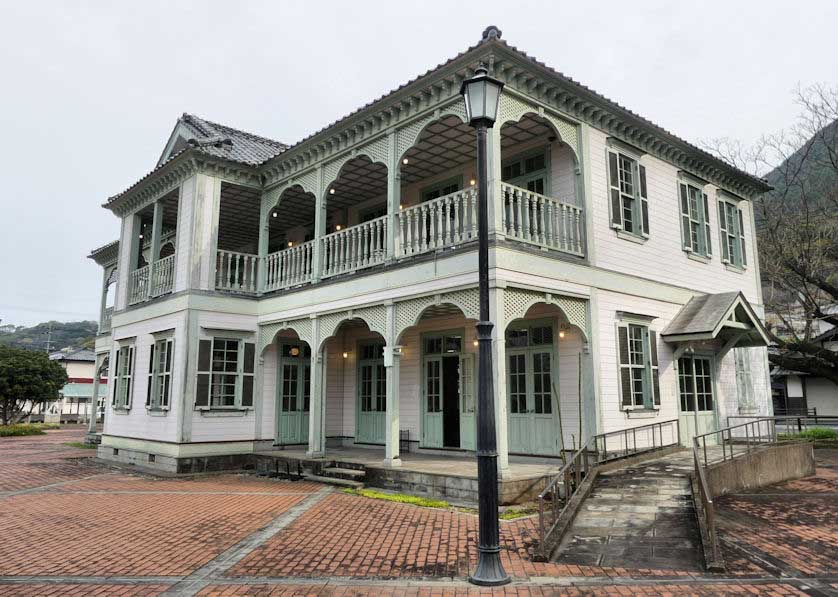
A reconstruction of the hotel that Lafcadio Hearn stayed in
Ferry services and connections to Amakusa Islands
Ferries play a crucial role in connecting Misumi to the Amakusa Islands, offering both a vital transport link and a scenic journey for visitors. The ferry terminal is conveniently located across from the JR Station, accessible via a covered walkway. Tickets can be purchased either at the train station or onboard the ferry.
The ferry route from Misumi first stops at Matsushima, situated at the northern end of Kamiamakusa Island. This scenic 17-minute ride passes between smaller islands, offering breathtaking views of the archipelago. From Matsushima, the ferry continues to Hondo, the main city on Amakusa's largest island, Shimoshima. The total journey time from Misumi to Hondo is just under an hour.
Ferry fares are reasonably priced, with a one-way ticket from Misumi to Matsushima costing 900 yen, and Misumi to Hondo priced at 2,200 yen. Children's fares are half-price, and round-trip tickets offer a slight discount. For those interested in wildlife, it's possible to book a one-day dolphin watching trip from Kumamoto, combining the A Train journey with a ferry ride and including lunch in Matsushima.
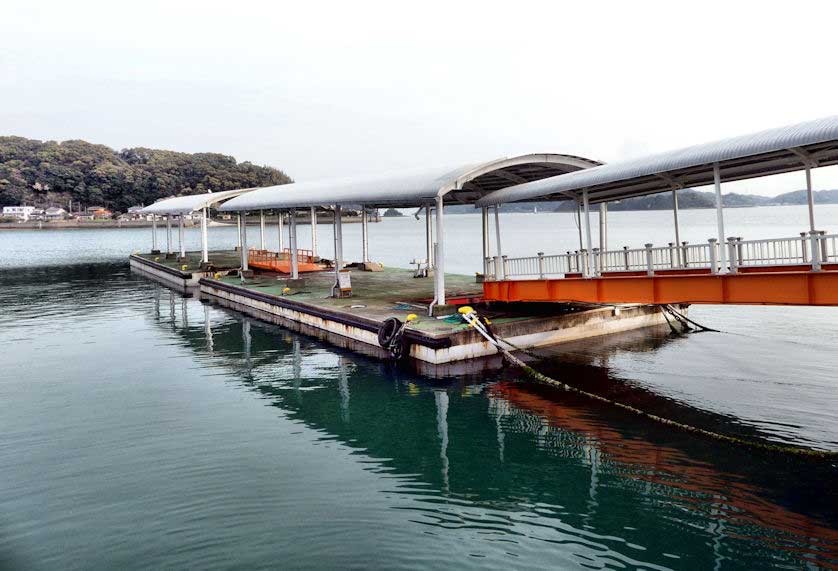
The dock for ferries to Amakusa from Misumi
Tourist attractions and activities in Misumi
While Misumi's main draw is its historical port and role as a gateway to Amakusa, the town and its surroundings offer several attractions for visitors to enjoy.
The Misumi West Port area itself serves as an open-air museum of industrial heritage. Visitors can stroll along the historic stone quay, which remains largely unchanged since its construction over a century ago. The waterfront area has been transformed into a pleasant park, ideal for leisurely walks and picnics with views of the sea and surrounding islands.
For those interested in architecture, the mix of Western and Japanese-style buildings in the port area provides a fascinating glimpse into the Meiji-era fusion of cultures. The grandest of these structures is a reconstructed Western-style hotel, originally built in 1887 but later moved to Dalian in China. The current building, reconstructed in 1993, now serves as an event hall and offers insight into the luxury accommodations of the late 19th century.
Nature enthusiasts will appreciate the scenic beauty of the Misumi area, with its rugged coastline and views of the Amakusa Islands. The nearby Okoshiki Beach, famous for its beautiful sandy curve visible at low tide, is worth a visit for those seeking coastal landscapes.
Architectural highlights and historical buildings
Misumi West Port boasts a remarkable collection of historical buildings that showcase the architectural evolution during Japan's rapid modernization. These structures blend traditional Japanese elements with Western influences, creating a unique streetscape that transports visitors back to the Meiji era.
Among the notable buildings open to the public are:
- The Old Courthouse: A fine example of early Japanese adaptation of Western judicial architecture.
- The Town Hall: Reflecting the growing importance of local governance in the Meiji period.
- The County Office: An administrative building showcasing the bureaucratic structures of the time.
- Shipping Company Office and Warehouse: These buildings highlight the port's commercial significance and the rise of modern business practices in Japan.
The Ryujokan, built in 1918, stands as another architectural gem within the World Heritage Site. This building exemplifies the later stages of Western-influenced architecture in Japan, incorporating more sophisticated design elements and construction techniques.
Perhaps the most intriguing building is the reconstructed Western-style hotel. Although not an original structure, it provides valuable insights into the luxury accommodations of the era and the growing influence of Western culture on Japanese hospitality.
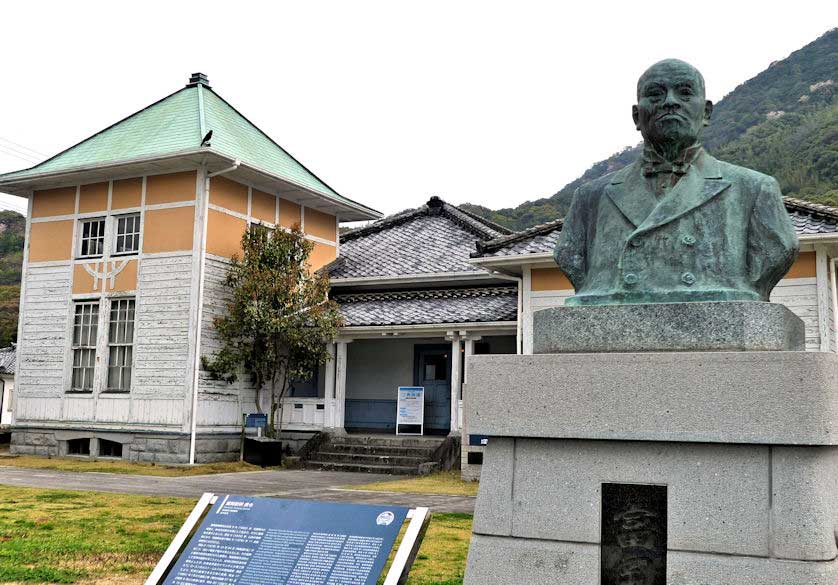
The Ryujokan built in 1918 at Misumi West Port World Heritage Site
Practical information for visitors to Misumi
For those planning a visit to Misumi, here's some essential practical information to ensure a smooth and enjoyable trip:
Access: Misumi is easily accessible by train via the JR Misumi Line. From Kumamoto Station, the journey takes about 52 minutes and costs 740 yen. The special A Train offers a more luxurious option for 1,880 yen, with a journey time of 27 minutes.
Local Transportation: Once in Misumi, most attractions are within walking distance of the station. For Misumi West Port, a short bus ride (220 yen, 10 minutes) or taxi (around 1,000 yen) is available.
Tourist Information Office: Located at 1159 Misumimachi Misumiura, Uki, Kumamoto 869-3207. Open from 8:30 am to 5 pm, closed on Mondays. Contact: Tel: 0964 53 0010.
Best Time to Visit: While Misumi can be visited year-round, spring (March to May) and autumn (September to November) offer mild temperatures and beautiful scenery. Summer can be hot and humid, while winter is cool but generally mild.
Accommodation: While Misumi itself has limited accommodation options, nearby Uki City and Kumamoto City offer a range of hotels and traditional ryokans to suit various budgets.
Food: Don't miss the opportunity to try local Kumamoto specialties such as basashi (horse meat sashimi), Kumamoto ramen, or karashi renkon (mustard-stuffed lotus root).
By keeping these practical tips in mind, visitors can make the most of their time exploring the historical port town of Misumi and its surrounding attractions. Whether you're a history enthusiast, architecture buff, or nature lover, Misumi offers a unique and rewarding experience in the heart of Kumamoto Prefecture.


